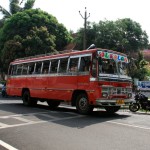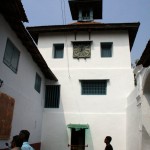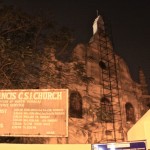Four Countries in 2 Weeks: Turkey, Bangladesh, Bhutan, and India
India Day 3 – A day in Kochi with a visit to Crafter’s, Paradesi Synagogue, and Mattancherry Palace in Jew Town followed by Santa Cruz Basilica and a Kerala backwaters tour. Then ending the day exploring the seaside with the Chinese Fishing Nets, the night market and the St. Francis Church.
Our all-nighter in Mumbai was taking its toll on us and we passed out most of the flight to Kochi. With our early arrival, we would have a full day and night to explore Kerala.
While in line for the prepaid taxi, a French girl named Celine asked us where we were going. It turns out we were all headed to Fort Kochi, so we shared a ride into town.
We spent the hour drive observing the tropical scenery and chatting with our new friend. She is moving to Kochi for a year to learn yoga and practice holistic healing.
Kochi
Our hotel came up first and we parted ways. We checked into Tissa’s Inn and planned out our touring for the day. The front desk ladies gave us an efficient itinerary to follow.
We took a leisurely stroll towards Jew Town in the east. Kochi seemed much more relaxed than Varanasi or Calcutta.
Crafter’s
The iconic antique store was located right on the main street of Jew Town. We stopped in to see the impressive collection of antiques for sale. The brother owners are also the proprietors of the hotel we are staying in.
They sat with us over a cup of tea discussing Kochi, tourism, and India.
Johny, one of the brothers, walked us to their other nearby store and showed us their prized possession, the largest varpu in the world! The brass bowl was huge and only stood on four small legs.
Paradesi Synagogue
One block away is the oldest active synagogue in India built in 1568. Checking our 5 rupee tickets at the door was Yaheh Hallegua, the youngest remaining female Paradesi Jew.
Inside the synagogue was decorated with Belgian glass chandeliers and other objects of antiquity. Unfortunately no pictures were allowed.
Mattancherry Palace
The Dutch Palace was another block away, passed the many souvenir shops. Built around 1555, it currently serves as a museum to display some grand murals of the different Hindu gods. There was also a collection of old tools and items from the everyday way of life.
After exploring the paintings, we headed back to the Fort Kochi.
A rickshaw driver offered to take us for free if we visited a store on the way. Apparently they get a point for each person they bring into the store and once they get five points the store gives them a free liter of petrol. Interesting trade.
Santa Cruz Basilica
We went directly to the landmark church. This Basilica was built in 1886, though the original church was erected in 1505. The first church survived the Dutch occupation, but was later demolished with the British took over in 1795.
This gothic building had impressive stained glass windows. There were students playing outside and watched us curiously as we surveyed the building.
We took a short walk back to the hotel and before we could even settle into the room, our phone rang. The reception called to say our car was here for the tour.
Kerala Backwaters
We had booked an afternoon boat ride through the Kerala backwaters for 1,970 rupees (~$30). Our driver took us on a frantic drive 45 minutes south of Kochi.
He parked us on the side of the road near a bridge, where we waited for our guide.
Fifteen minutes later a group of foreigners appeared and loaded into a van. The captain of our river boat led us to his vessel.
We sat aboard the thatched roof boat on white plastic chairs as he had a chai break. Soon after another rower arrived with the captain and we were on our way.
The tour took us around the still backwaters. It was very peaceful as we glided on the mirror-like surfaced river among palm trees and bright green foliage.
The main activity was spotting the birdlife. We saw a Brahminy Kite (sea-eagle), swallows, herons, cormorants catching fish and the famous White-throated Kingfisher.
with palm trees and lot of green foliage
On our way a coconut fell into the water with a large splash. Our guides quickly steered the boat to the river’s edge to pick it up. They seemed very pleased.
We made one stop at a local village. Disembarking our guide showed us different plants and vegetables that the villagers planted. Three men were busy waterproofing a canoe when we arrived. They glanced at us and continued with their work. We saw how the locals made yarn by spinning coir, the fiber from coconut husks. A young girl sat on her porch with a tray of snacks and spices to sell.
The whole tour took about two hours to complete a full circle. Towards the end the captain let us row the boat. We returned to the starting point just in time for the sunset.
Chinese Fishing Nets
Back in Fort Kochi we went to see the fishing nets along the beach. It was quite dark already, but we could still make out the design. Meanwhile the boardwalk turned into a bustling night market.
Shops were selling fresh fish from the day’s catch while cooks were offering their services to prepare the fish for dinner. Children were dragging their parents to the ice cream and popcorn carts.
St. Francis Church
A short walk from the seaside was the oldest European church in India, built in 1503. The explorer Vasco da Gama, died in Kochi and he was originally buried in at church, before his remains were returned to Portugal.
Unfortunately the church was closed at this hour so we only had an exterior view.
An auto-rickshaw took us back to the hotel from which we wandered a few blocks to find a local Indian restaurant. Relaxing over a light meal of curry and rice, we recounted the Kochi experience.
Still running on no sleep from the previous night and knowing we had to rise early for our flight to Delhi, we made an effort to get some rest.
Our tour around Agra, Jaipur, and Udaipur is up next!



































